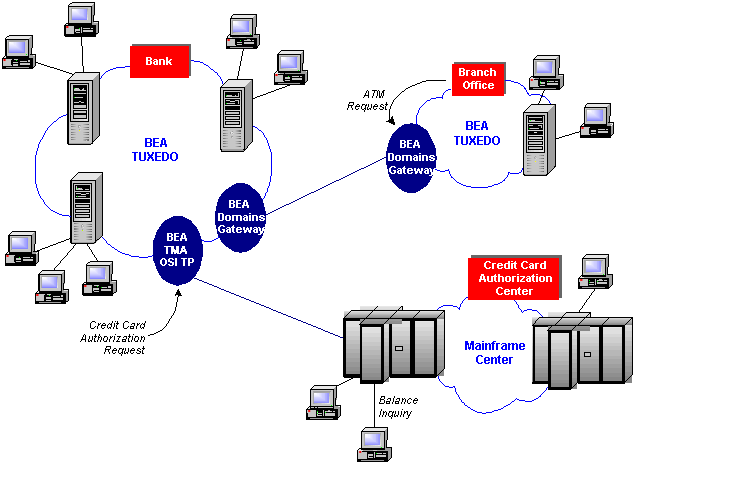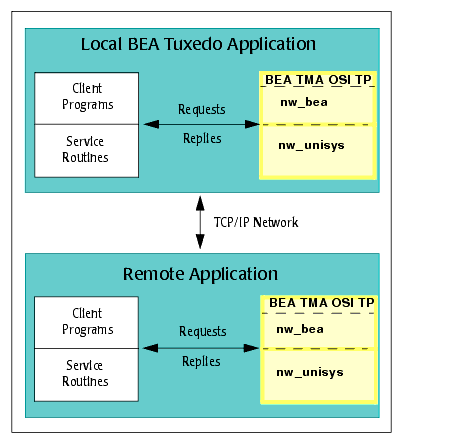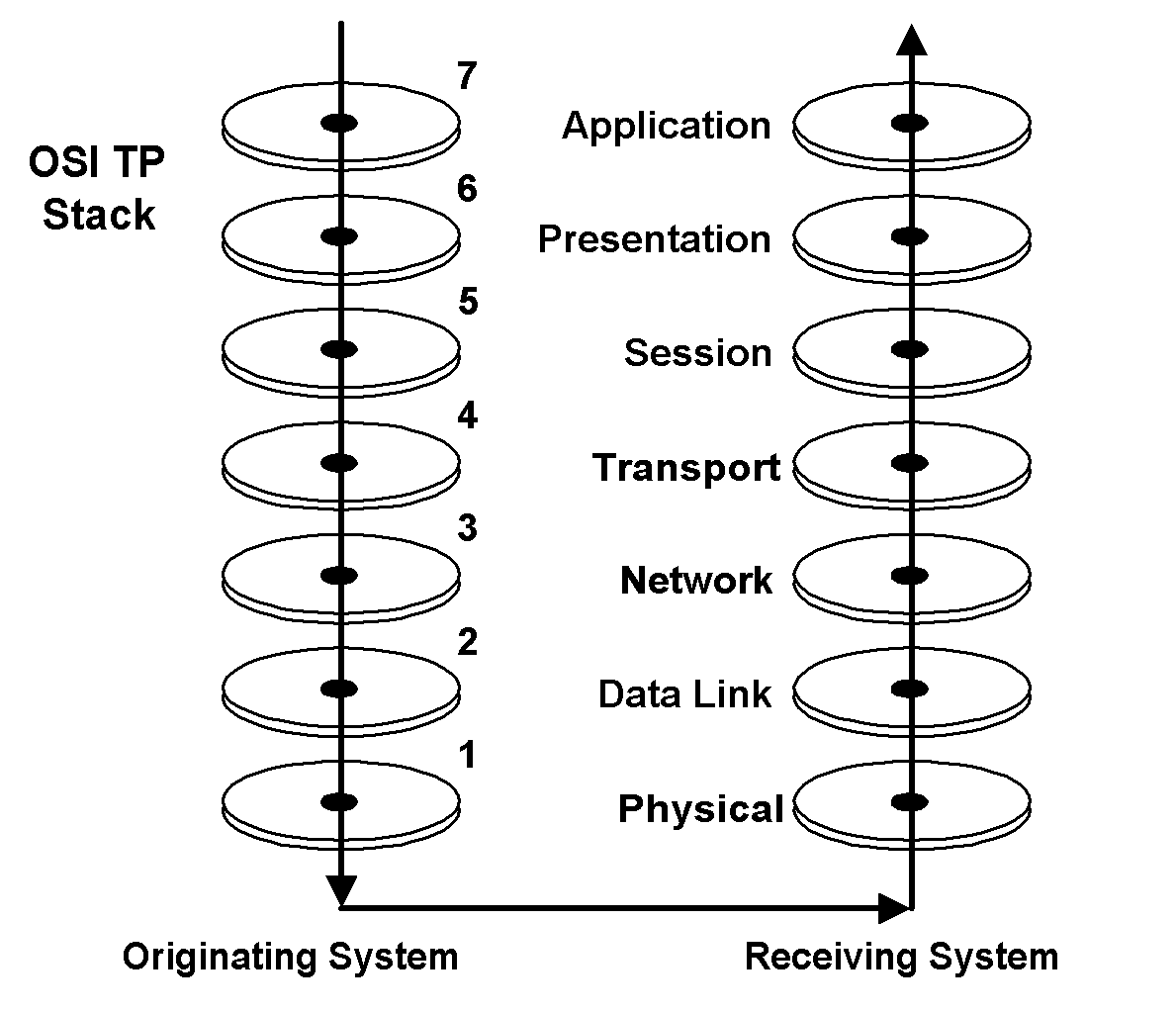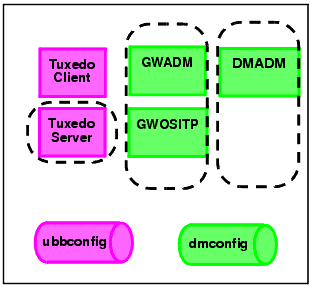









|
This section covers the following topics:
BEA Tuxedo Mainframe Adapter for OSI TP is a gateway connectivity product that makes it possible for OLTP application programs on BEA Tuxedo systems to perform global transactions and various non-transactional tasks with application programs in the following environments:
BEA Tuxedo Mainframe Adapter for OSI TP implements the OSI-TP standard, a set of protocols that is used to:
The Open Group XATMI standard is an interface that application programs use to communicate with other application programs both inside and outside of global transactions. It supports conversational and request/reply communication styles and is fully implemented by TMA OSI TP.
Data mapping and transformation between the BEA Tuxedo and mainframe environments is easily automated in BEA Tuxedo-based applications with the BEA Tuxedo typed buffer mechanism. This mechanism allows system administrators to predefine how data should be conveyed to the remote application. Application programmers do not need to be aware of this translation; they can simply continue using the buffer types defined for the local application. The TMA OSI TP software is designed to provide transparent access to remote services that reside outside a BEA Tuxedo application. In addition, TMA OSI TP provides remote application programs with access to local services.

The TMA OSI TP product supports the following features:
AUTOPREPARE feature that allows requests to remote services to be automatically prepared
A BEA Tuxedo application consists of client and server programs that operate across a network of BEA Tuxedo systems. Any client program can request services that are offered by any server program running on any computer in the application. The location of server programs is kept transparent because remote services are mapped to servers in a section of the configuration file. The TMA OSI TP architecture comprises two distinct internal components, nw-bea and nw-unisys. These two internal components extend the transparent access of the BEA Tuxedo system by sending requests to and receiving requests from remote systems through OSI TP and supporting network software. Figure 1-3 shows how this transparent access works.

The TMA OSI TP software is implemented as an ordinary BEA Tuxedo server group that accepts standard BEA Tuxedo service requests and returns standard replies. The TMA OSI TP server group consists of the following components:
One TMA OSI TP server group acts as a gateway to multiple remote systems. The Tuxedo connection manager can either:
If you use multiple communication targets, you have a unique OSI TP endpoint called an association. When using unique communications targets, there is one association or connection to the remote system for each call to the remote system. After the call is complete, that association is reused by subsequent calls. There is a connection to the remote system for each simultaneous call made to the remote system. The association is released after a pre-set timer expires, turning unused resources back to the system. This pre-set timer is controlled by parameters specified in the OSI TP tailor file. Refer to Tuning OSI TP-Specific Tables with the TAILOR File for more information.
To multiplex all communications per remote system, you must have the version of TMA OSI TP that has this feature and your remote system must support OSI TP multiplexing. When using multiplexing, all data is streamed or collected and sent to the remote system. Data messages are sent and received in an efficient manner increasing scalability and performance. The XATMI data representation is still used, but the representation of internal OSI TP data exchanges is optimized.
Some remote targets, such as remote BEA Tuxedo applications, also support BEA TMA OSI TP. In this situation, TMA OSI TP servers associated with the local gateway communicate with TMA OSI TP servers associated with remote gateways through OSI TP.
Other products such as remote Unisys A Series Open/OLTP systems, Unisys OS2200 systems, Unisys OpenTI for MTS interoperability, and ICL TPMS for Open VME provide analogous functionality with which local TMA OSI TP servers can interact.
The TMA OSI TP software maintains its own control information in shared memory, in much the same way that BEA Tuxedo software itself maintains the Bulletin Board. Although TMA OSI TP accesses the BEA Tuxedo Bulletin Board, BEA Tuxedo does not access TMA OSI TP control information.
To a remote system that supports the Open Group XATMI standard (more specifically, an XATMI application service element), the TMA OSI TP server group appears as a communications resource manager (CRM).
When the multiplexed protocol is used, flow control is implemented in the following manner. When the amount of data buffered to a particular RDOM exceeds the threshold defined by StartFlowControlThreshold, GWOSITP sends a request to Tuxedo to unadvertised all services associated with the particular LDOM and RDOM involved. This allows all call and connect requests already accepted by GWOSITP to complete normally without being aborted. If one or more redundant RDOMs are configured with the same services advertised, then Tuxedo will automatically route new requests to these other RDOMs. If no other RDOM advertises the services, new tpcall or tpconnect requests will get a TPENOENT error.
When the amount of data buffered to a particular RDOM falls below the threshold defined by StopFlowControlThreshold, GWOSITP sends a request to Tuxedo to advertise all services associated with the LDOM and RDOM involved.
Because of the lag time between detecting flow control and unadvertising the services, it is possible for the amount of buffered data to exceed the value of StartFlowControlThreshold by a significant margin. Therefore, care should be taken when configuring StartFlowControlThreshold with a large value.
| Note: | For more information about the StartFlowControlThreshold and StopFlowControlThreshold parameters in the TAILOR file, refer to
Tuning OSI TP-Specific Tables with the TAILOR File. |
Open Systems Interconnection (OSI) is a computer network architecture developed by the International Organization for Standardization (ISO) in cooperation with other standards Organizations. OSI standards define protocols for communication between diverse computer systems in a network.
By conforming to OSI standards, computer hardware and software vendors can enable applications on a local computer system to communicate with applications on remote computer systems that are manufactured by another vendor or have a different architecture from the local system.
The OSI architecture is based upon a framework that divides the networking tasks and requirements into seven layers. The layers are groups of related functions or tasks, intended to make their interfaces and functions easier to understand.
Each layer contains entities that perform specific functions in the communication process. Entities throughout the network that are in the same layer and perform the same functions on different systems are called peer entities. They communicate with each other in a standard way. This is called protocol.
In the OSI Reference Model, peer entities cannot communicate directly. On the sending system, a layer entity uses peer protocols to attach a header containing routing and control information to the message being sent. It then passes this information down to the next layer. That layer adds its own header information and passes it to the next lower layer.
When the message reaches the receiving system, entities in each layer:
The following figure illustrates the seven common protocol layers of the OSI Reference Model.

OSI TP works with Tuxedo to provide the following services:
The TMA OSI TP software acts as gateways between BEA Tuxedo systems and other online transaction processing environments. Connections with remote systems are established by configuring TMA OSI TP as an ordinary BEA Tuxedo server group that identifies remote systems and available services.
The TMA OSI TP gateway is composed of several elements that can be configured to provide OSI TP solutions. For the most part, the OSI TP domain is much like the other domain gateways. It uses the DMADM and GWADM servers provided with BEA Tuxedo for administration.
The following diagram describes each component of the TMA OSI TP product.

BEA Tuxedo Mainframe Adapter for OSI TP uses the following administrative servers for domain and gateway configuration and administration:
| Note: | The gateway, GWOSITP, must be started AFTER the other servers. |
Specific information on configuring the various sections of a domain are covered in the BEA Tuxedo document, BEA Tuxedo /Domain Guide.


|